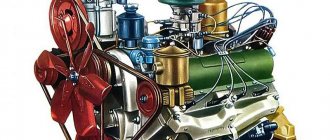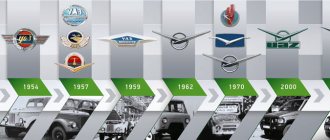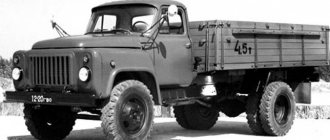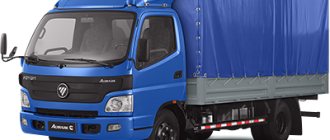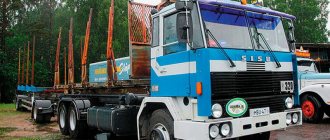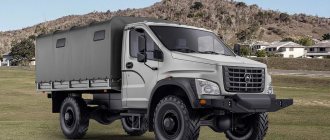First steps
By the early fifties, the ZIS-150, the development of which began in the pre-war period, became obsolete. ZIL-164, serial production of which began in 1957, turned out to be only a temporary solution. In fact, it was a deep modernization of the same 150th model. The state needed a completely new car. The first prototypes of the ZIL-130 with a lifting capacity of four tons were built at the end of 1956. Under the hood, an in-line six-cylinder ZIL-120 engine, familiar from the previous model, was installed. But soon this engine was abandoned in favor of a new unit. The V8 engine with a displacement of six liters produced 150 hp. The compression ratio was only 6.5 units, but the engine could run on 72-octane gasoline. It took six years to fine-tune and test the car, and the first experimental batches were assembled in 1962. But the machines required additional development tests. Large-scale production started only on October 1, 1964.
Engine ZIL-508
The overhead valve V8 engine was similar in design to the engine of the ZIL-111 limousine.
However, on the 130th, the six-liter engine developed only 150 hp. But I ate 72 gasoline. The overhead valve V8 engine was similar in design to the engine of the ZIL-111 limousine. However, on the 130th, the six-liter engine developed only 150 hp. But I ate 72 gasoline.
Appearance to the people
The truck turned out to be innovative at that time, with a level of comfort unprecedented for a Soviet driver. The steering was power-assisted, and the five-speed gearbox was equipped with synchronizers for all but first gears. The car moved off easily from the second, and the first stage was needed only for off-road conditions or very steep climbs. That's why they made it straight-toothed.
Body Features
All types of body imply either rear unloading or unloading to the side. The dimensions of the body are as follows: the height is equal to the height of the railway car, which speeds up loading/unloading; platform area is 8.7 m2; The body volume of a standard ZIL-130 dump truck is 5 cubic meters. In Soviet times, the large size of the body, as well as the spacious ZIL cabin, made it possible to use the vehicle for transporting workers. See the table for body volume data.
| With installed sides | 7.8 m3 |
| Without sides | 5 m3 |
| Platform area | 8.7 m2 |
| Unloading directions | Straight and sideways |
| Climbing angle | 50 gr. |
| Platform size | 2325 by 3752 mm |
Hydraulics
The body lifting/lowering technology includes a 17 liter hydraulic fluid tank, a mechanical pump and a lifting hydraulic cylinder.
Load capacity and overall dimensions
The ZIL-130 dump truck initially had a load capacity of 4 tons; At present, the carrying capacity of the ZIL-130 vehicle has reached 6 tons. A maximum load of 2.625 tons is possible for the front axle, and 7.9 tons for the rear axle. In the table, we consider the general dimensions of this truck.
| Width (in millimeters) | 2500 |
| In height | 2400 |
| In length | 6675 |
| Wheel base | 3800 |
Prototype ZIL-130, 1956
The photo shows a prototype of the first series, built in 1956.
The photo shows a prototype of the first series, built in 1956.
The exterior of the truck was very bold, even by international standards. The appearance was entrusted to a young graduate of Stroganovka (Moscow School of Art and Industry) Erik Vladimirovich Sabo. Until then, and even later, there was nothing like this among our cargo vehicles. Embossed radiator grille, stylish cabin contours and, most importantly, a panoramic windshield! Only the government GAZ-13 Chaika and ZIL-111 could boast of such elegance.
Advantages and disadvantages
ZIL cars became popular not only in the USSR, and then in Russia. They were used all over the world. Even modifications were created for tropical countries. And, of course, many found these cars convenient and practical, but there were also disadvantages.
ZIL MMZ 4502
Advantages of the car
- Easily accessible. Any collective farm or enterprise could afford to purchase such a truck. The price range was affordable for many. Moreover, spare parts, as well as repairs to the truck base, cost the most insignificant amounts.
- Convenience . At the time of mass production of the car, the ZIL was considered a luxury car. It had a cabin for three people, with a comfortable panoramic windshield, as well as an excellent heating system.
- Load capacity. The vehicle's tonnage made it possible to transport non-critically heavy loads, but for agricultural work or urban maintenance it was quite enough.
- Patency . The car coped well with the most severe problems with the road surface and country roads. For this reason it became the favorite of many drivers.
ZIL-130 from the first experimental batch in 1962
The car is from the first experimental batch of 1962.
To fine-tune the new ZILs, they were sent on long test runs in the Far North. The car is from the first experimental batch of 1962. To fine-tune the new ZILs, they were sent on long test runs across the Far North.
Another distinctive feature of the new car was the color. Before this, the main color for the vast majority of Soviet trucks was khaki - in order to quickly mobilize in case of war. But the 130 received a sky blue cab with a white front end. Of course, there were other colors, including dark green. But most of the cars were blue.
ZIL-130
Serial ZIL-130 model 1964.
The car was produced in this form until 1978. Serial ZIL-130 model 1964. The car was produced in this form until 1978.
ZIL-130 quickly won the love of drivers. It turned out to be beautiful, dynamic and comfortable. The carrying capacity was five tons - more than the vehicle's own weight. But the main thing is that it turned out to be very durable. The estimated mileage before major repairs of 300 thousand kilometers was a very decent figure for the sixties. In May 1973, large-scale endurance tests of the 130th were carried out at the NAMI test site. He covered a distance of 25 thousand kilometers in 12 days. At the same time, not a single breakdown was recorded. But the incredibly successful design partly became the curse of the plant...
Interesting Facts
At the ZIL branch in Chita, the northern version of the ZIL-130S was assembled, which was equipped with a winch driven by a gearbox. The machine was intended for operation at temperatures down to -60°C. The cars were painted in bright orange or red, as well as army khaki.
Since 1973, ZIL-130 trucks and chassis had the USSR State Quality Mark, which confirmed the high performance of the products.
Today, ZIL-130 trucks are outdated and are gradually being written off due to deterioration of the structure and significant fuel consumption.
The remaining units are converted by replacing the gasoline engine with a diesel unit (usually a product of the Minsk Motor Plant D-245). Early production trucks are very rare and have become collector's items.
ZIL-130 at autocross
Good power supply and a durable cabin made the ZIL-130 an excellent crossman.
The 130s continue to compete in autocross today. Good power supply and a durable cabin made the ZIL-130 an excellent crossman. The 130s continue to compete in autocross today.
Late shift
Of course, no one was going to rest on their laurels. No matter how successful the design, progress does not stand still. And we need to prepare a successor. But in the late 60s, ZIL designers were busy developing a family of cabover trucks with a diesel engine and a load capacity of eight tons. In December 1969, the first samples of the new ZIL-170 vehicle were assembled, which later became the KAMAZ-5320. Only in 1976, when mass production of KAMAZ vehicles was launched in Naberezhnye Chelny, the Likhachev plant finally began developing its own car, the successor to the 130. However, time was lost. ZIL-130 was completely outdated by that time.
Key points
In the technical specifications dated August 29, 1956, approved by the Ministry of the Automotive Industry of the USSR, the plant named after. I.A. Likhachev was required to develop a project for a new two-axle truck ZIL-130 with rear axle drive for transporting goods on roads of all categories, as well as for towing general-purpose trailers on paved roads.
The need to create a new family of trucks was dictated by several circumstances. The four-ton ZIL-164 previously produced by the plant was obsolete; the national economy of the USSR required heavy-duty trucks. In addition, ZIL-164 became uncompetitive in the foreign market.
The terms of reference, on the one hand, provided for the creation, based on the main units of the new ZIL-130 truck, of single modifications of an agricultural dump truck and a long-wheelbase vehicle for transporting large-sized cargo with low density. On the other hand, during the design it was necessary to ensure the possibility of creating both a tractor-trailer for use with a trailer on paved roads, and a dump truck chassis for working with an excavator on construction sites. At the same time, based on the widespread use of components and parts of a two-axle vehicle, it was planned to develop a three-axle truck ZIL-131 in two modifications - traction and transport.
It should be noted that the truck was developed and mastered during Khrushchev’s “thaw” - a period of great revival and growth in the life of Soviet society. The Zilov team used the experience of this large-scale, successful and in many aspects pioneering work in subsequent projects, in particular when creating the KamAZ-5320 and ZIL-4331 families of vehicles.
The chief designer of the ZIL-130 truck and its derivatives (models and modifications) was Anatoly Mavrikievich Krieger, who moved to Moscow from the Gorky Automobile Plant in July 1954. And already in 1956, the first prototypes of the “one hundred and thirties” appeared. In the surviving photographs of these samples, you can find a version of the car very similar to the one that is found on Russian roads today.
Prototypes of the ZIL-130 were born simultaneously with the explanatory note for the car project, a whole year before the approval of the landing model. This speed can be explained by two reasons. Firstly, the plant spent several years working to modernize the ZIS-150 and then the ZIL-164 vehicles, which made it possible to create a solid creative foundation for the units. Secondly, the concept of the future car was probably clear to the chief designer from the very beginning. During his long business trip to the United States, he had the opportunity to become familiar with the production of automobiles, and his knowledge of the language allowed him to follow the development of their designs in the technical literature.
It is no coincidence that the serial Dodge SZ-TA8 truck produced in 1956 was also considered among the possible prototypes. The last circumstance was especially important from the point of view of finding design solutions for the cabin of the designed ZIL-130 truck. The creators perceived the cabin as a complex and necessary component of the car, and not as a forced part of the driver’s workplace.
In the adopted layout of the ZIL-130 vehicle, the size between the axle of the front wheels and the rear wall of the cabin became critical. Its size (1650 mm) was quite consistent with similar parameters of American cars of the mid-1950s: International R135 (1955) - 850 mm; REO F22R-1 (1956) – 1635 mm. For the domestic ZIS-150 (1948) this value was 2025 mm. The maximum possible reduction in this size was ensured by a short V8 gasoline engine. A significant role was played by the reduction in the length of the cabin; it was shifted even further onto the engine, but for this purpose a niche was made in the lower part of the dashboard (engine shield). Thus, in terms of its layout, the ZIL-130 car can be called a short-bonnet one.
The choice of the shape of the wind window, which is made in the form of a deep panorama overlooking the sidewalls, like the Dodge SZ-TA8 car, turned out to be very binding, and not only from the point of view of external architecture. This circumstance provided excellent visibility, close to that of the “cab-over-engine” layout and made it possible to follow the latest fashion trends of the mid-1950s, which gave the “one hundred and thirty” a unique individuality for 40 years.
At the same time, the design of the cabin became significantly more complicated; its manufacture required additional metal costs. But the choice of the chief designer cannot be considered random. There were plenty of trucks with a straight vertical front pillar and panoramic windshield glass at that time. Dodge SZ-TA8 was one of the first. Others include the 1956 Ford C-Series cab-over/behind-engine; 1957 GMC 350 to 630 series with the same layouts; hooded GMC B5000 1960; 1956–1958 Dodge C- and D-series (flatbeds, truck tractors, dump trucks and pickups); International cars, Chevrolet and some others. American Dodge SZ-TA-8, International P-185 and REO F22-R1 trucks took part in comparative tests with prototypes of the third ZIL-130 series, which ended in December 1960. Based on their results, the “one hundred and thirties” family was recommended for state tests .
The panoramic glass used on the ZIL-130 was immediately protested by the military. An important stage in the creation of the cabin was the approval of the landing mock-up on January 19, 1957, when there was no mock-up of the external shape as such. The only fundamental decision was to increase the width of the cabin at shoulder level to 1600 mm. For the ZIS-150 this size was 1530 mm. The angles of inclination of the door glass to the vertical were reduced, but the base of the cabin was retained. This required an almost complete rework of the plaza and drawings. Typically, the shape of the cabin (in a professional environment it is correctly called the body) is presented in a mock-up, in which it is easier to eliminate the noted shortcomings. In this case, the appearance of the cab body was demonstrated and approved “live”, on prototypes of ZIL-130 and ZIL-165 (ZIL-131) vehicles.
An important event occurred on December 9, 1957. The protocol approved by the head of the Automotive and Tractor Directorate of the USSR Ministry of Defense (AVTU MO), Colonel General Korovnikov, and the USSR Minister of Tractor and Agricultural Engineering Khlamov, said: “Having examined the samples of cars ... in appearance and main dimensions of the cabin ... approve the proposed cabin and recommend that the plant begin preparing production for the specified cabin.” From the text of the protocol it follows that Korovnikov agreed that the ZIL-131 army vehicle would have panoramic glass.
The warning of the senior military representative of the plant, engineer-colonel Semenchenko, to the scientific and technical committee of the Autonomous Technical University of Moscow Region that “a panoramic windshield is unacceptable for an army vehicle, since this is associated with great difficulties in replacing it, as well as the difficulties of transporting curved glass,” was not taken into account. The protocol included the following entry: “Panoramic glass should be approved with a cut in the middle.” Somewhat later, the customer agreed to replace the material of panoramic laminated glass of the triplex type with a tempered version (Stalinite). In connection with this, preparations for triplex production were stopped, and the almost finished line was dismantled.
The issue of the shape and design of the ZIL-130 was decided on May 6, 1958. By that time, the full-size mock-up of the cockpit was ready, and the tail of the ZIL-130 was presented only on its right side. It was this arrangement that was adopted for mass production. The protocol was signed by 20 chief specialists and approved by the chief engineer of ZIL K.V. Stroganov. The appearance of the ZIL-131 was approved by the chief designer A.M. Krieger and chief technologist P.A. Tsvetkov June 21, 1958. The tail of the ZIL-131 was made on the left side of the model. The performers of both models were sculptors A.M. Pershin and V.I. Esakov and senior designer A.P. Chernyaev.
It remains to add that the tail model was made for a car with an in-line overhead valve 6-cylinder engine. After reorientation to the V8 engine, the tail length was retained. As for the ZIL-130 radiator lining adopted for production, its shape was specified by A.M. Krieger was finally determined by the leading artist T.P. Kiseleva.
The question of improving the external shape of the cockpit and tail surface arose very soon - at the beginning of 1963 - a year and a half before the start of assembly line production. The decree of the Moscow Economic Council of 02/08/1963 ordered the special art and design bureau (SKHKB) at the Moscow Economic Council of Light Engineering to modernize the cabin and unify the tail surfaces of the ZIL-130 and ZIL-131.
The piquancy of the situation was that the Economic Council’s design artists turned out to be yesterday’s “Zilovites.” Through their efforts, for example, the ZIL-118 “Youth” bus was created, which won 12 prizes at the bus week in Nice, France in 1967. Unfortunately, the proposals of the Economic Council members, implemented in the 1:2.5 layout and corresponding drawings, were not accepted at ZIL. Somewhat later, at the end of 1964, in the experimental workshop, according to the preliminary drawings of the body design bureau, a prototype of the 3EZIL-130 cabin with a new tail was made. To facilitate access to the engine, the connector between the hood and the wing was lowered by 100 mm, and the number of bolts securing the empennage to the cockpit was reduced from 18 to 6.
The tail of the ZIL-130 and ZIL-131 was unified, i.e. made suitable for both models. To improve the sealing of the cabin along the contour of the door openings, internal hinges were used, which ensured the continuity of the seals along the entire perimeter of the opening. The project was an initiative of a group of designers; A.P. became the main composer. Chernyaev. The design was approved by technologists and chief engineer K.V. Stroganov. However, assembly lines and conveyors have already begun their non-stop movement. Thus, time was lost.
ZIL-130 was put into mass production as part of a whole family. The car was equipped with a new petrol V-shaped 8-cylinder ZIL-130 engine, derated to 150 hp, power steering and a cabin that was quite advanced for those times. As for the exterior architecture, the tense, “inflated” shape of the main cladding panels, except for the rear cabin, emphasizes the need to provide stamping stability and rigidity with a minimum of thickness. Everything else left freedom of choice to artists and designers.
It should be noted that the minimized cabin was not designed and adapted for any transformations. There was no option for a sleeping place. With an internal width at shoulder level of 1600 mm, such a project turned out to be unrealistic. The same situation existed with a 2-row 6-seater cabin intended for fire trucks.
Dump truck MMZ-555, also known as ZIL-130D.
One of the first modifications was the MMZ-555 dump truck, also known as ZIL-130D.
One of the first modifications was the MMZ-555 dump truck, also known as ZIL-130D.
Only in 1978, the updated 130-76 car was put into production, which is easily distinguished by its modified “face” (the sidelights and headlights swapped places). And in 1986, the car received a new index - 431410. But no matter what it was called, it was still the same 130, the main drawback of which was the voracious gasoline engine. And if the diesel unit for KAMAZ was created by the Yaroslavl Motor Plant, then ZIL had to develop its own diesel engine from scratch. Work on the car and engine was long and painful. As a result, the successor to the 130th, ZIL-4331, reached the production line only in 1987. But not all cars were equipped with the new ZIL-645 diesel engine. Most new cars were produced with the same gasoline engine.
Return of Youth
The fastest result could be obtained by using a car that was already in production and mastered in production. On the instructions of the chief designer of the plant, V. G. Mazepa, one of the buses of the ZIL-3207 “Yunost” family was converted into a pickup truck. The roof of the bus was cut off, everything except two seats in the front was removed, and the side service door was welded shut. A gas tank was placed in the step behind the door, and the neck was brought directly under the panel of the former door and the lid was carefully attached. Iron arches were attached to the top, over which a dark blue awning was stretched. All this work was started and completed in 1992, taking only a few months. The new product with a lifting capacity of 2 tons received the index ZIL-3207G (also known under the index ZIL-3302). The quick result in a short time looked beautiful and interesting, but putting it into production gave rise to an innumerable number of problems.
Created for small-scale manual production, this bus did not have dies for stamping body panels. Structurally, the car was frameless, and the body consisted of a large number of amplifiers, gussets, inserts and other elements that would have to be abandoned in favor of a small number of solid elements for stamping. And this, in turn, would require alterations in the drawings of the entire bus. The job is not for one year. In addition, the overall length and width of the cargo compartment (4.0 x 1.7 meters) were small, plus the wheel niches bulged out in the body, and loading could only be done from the rear through a narrow (700 mm) door.
Another disadvantage is the large 8-cylinder 6-liter ZIL-130 carburetor engine, which was cheap and reliable, but at the same time power-hungry and heavy for a small commercial vehicle. The problem of the Yunost was its original independent front suspension, which traces its origins back to the ZIS-110 produced in 1945 and requires a bulkhead on this particular vehicle every 20,000 km. In urban conditions and on roads with good asphalt, it gave excellent results in terms of smoothness, but the truck is not a luxury bus; it will be driven into the mud, onto rocks, and into the forest. And they will probably load above the norm, which is a life practice. As a result, the ZIL-3207G remained a single copy, which for a long time traveled around the factory workshops as an intra-factory delivery vehicle.
Long-wheelbase modification ZIL-431510
In 1986, ZIL-130 changed its index to 431410 (in the photo there is a long-wheelbase modification 431510).
The car was produced in this form until 1994. In 1986, ZIL-130 changed its index to 431410 (in the photo there is a long-wheelbase modification 431510). The car was produced in this form until 1994.
In fact, the new truck was a deeply modernized “one hundred and thirty” with a new cab. Moreover, both generations of cars were produced in parallel. The last ZIL-431410 rolled off the assembly line already in post-Soviet times - in 1994. Over the thirty years of production, the ZIL-130 has acquired a large number of modifications. And the total circulation was almost three and a half million copies! This makes the 130 not only legendary, but also one of the most popular cars in the history of our automobile industry.
Use of ZIL trucks in the military sphere
In addition to purely civilian service, the ZIL vehicle was widely used in the military sphere. Various modifications and variations served the army for a long time. The most popular of them were:
- Infantry transport. A flatbed truck with an awning and benches inside for transporting soldiers. Used in many countries around the world;
- Pile installer. Special equipment installed on the truck made it possible to install piles for temporary crossing bridges. Used in the USSR and CIS countries later;
- Field kitchen or bathhouse. These two modifications served in support and were an integral part of the deployment of troops;
- Freight. Specialized cargo ZILs for transporting a variety of cargo for military purposes. From ammunition to missile launchers;
- Radar installations. Radars were installed on some modifications of the ZIL. Used in communications and reconnaissance units.
ZIL-4331
ZIL-4331, the successor to the 130th, was clearly late for publication.
And it didn’t turn out quite the way it was intended. ZIL-4331, the successor to the 130th, was clearly late for publication. And it didn’t turn out quite the way it was intended.
His successor didn't come close to achieving the same popularity. With the transition to a market economy, a medium-duty truck with a gasoline engine found itself out of work. The ZIL-645 diesel engine was crude and required modifications, for which there was no longer enough money. The plant tried to launch the production of model 4331 with MMZ and Caterpillar engines. But everything is in vain. Demand was revived by the ZIL-5301 Bychok, developed in a short time, but the effect turned out to be temporary. We know very well how it all ended for ZIL. However, this is a completely different story. And today the 130th continues to serve faithfully in many enterprises and farms. This pensioner has long deserved peace. But I am sure that we will see the legendary truck on the roads for a long time.
Personal acquaintance |
| I myself had the opportunity to communicate with the 130th ZIL, while still a student at a driving school. For category C training, there were two ZIL trucks in the fleet: 4331 and 431410 (read: 130th). I got the second one. Almost twelve years have passed since then, but the memories of managing ZIL are still fresh. The engine started easily and ran very smoothly. They say that with a properly tuned motor, the compressor should be heard better than the motor itself. It was just about a training machine - the engine rustled barely noticeably. Interestingly, ZIL-4331, which was fifteen years younger, was in much worse condition. From second gear the 130 started off very easily and accelerated very confidently. Feedback and quick reactions on the steering wheel, which we evaluate during comparative tests, are not about this car. For ZIL, the main thing is that the steering wheel turns easily. The only thing that caused discomfort in the crowded traffic on the streets of Moscow was poor visibility. Still, the hood and front fenders were high. But I still remember that car with warmth. |
Device ZIL-130
Great Soviet Encyclopedia.
Volume one. In the section about the car, the header is an image with the 130th ZIL and its device. Great Soviet Encyclopedia. Volume one. In the section about the car, the header is an image with the 130th ZIL and its device.
ZIL-130 | |
| Overall dimensions: length/width/height/base | 6675/2500/2400/3800 mm |
| Curb/gross weight | 4300/10525 kg |
| Towed trailer weight | 8000 kg |
| Maximum speed | 90 km/h |
| Turning radius | 8.9 m |
| Fuel/fuel reserve | AI-72/170 l |
| Fuel consumption at a speed of 60 km/h | 29 l/100km |
| ENGINE | |
| Type | petrol |
| Location | front, longitudinal |
| Configuration/number of valves | V8/16 |
| Working volume | 5996 cm³ |
| Compression ratio | 6,5 |
| Power | 110/150 kW/hp at 3200 rpm |
| Torque | 401 Nm at 1800 - 2000 rpm |
| TRANSMISSION | |
| type of drive | rear |
| Transmission | M5 |
| Gear ratios: I/II/III/IV/V/Z.kh. | 7,44/4,10/2,29/1,47/1,00/7,09 |
| main gear | 6,32 |
| CHASSIS | |
| Suspension: front/rear | dependent spring |
| Steering | screw-nut, with hydraulic booster |
| Brakes: front/rear | drum, pneumatic |
| Tires | 260–508(P) |
Photo: from the author’s archive
ZIL-130: remembering the life of the legendary truck
Transmission
The synchronous rear-wheel drive gearbox is equipped with helical gears of constant clutch. Torque is supplied to the rear axle, as a result of which the ZIL-130 “Kolkhoznik” has better grip on dirt and asphalt roads.
| Volume in l. | 5.99 |
| Rotation in rpm | 3200 |
| Temperature reduction method | Air-liquid |
| Tank volume, l. | 176 |
| Maximum speed km/h | 90 |
| Switch box | Mechanics |
| Number of positions | 5 |
| Drive unit | Rear wheel drive |
